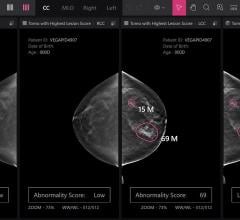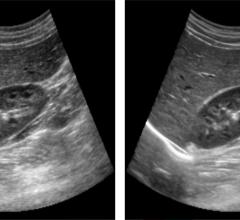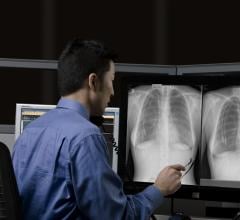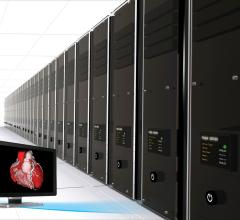Toshiba America Medical Systems Inc.’s Dose Tracking System makes interventional procedures safer for patients by measuring peak radiation skin dose during the exam. To expand clinical applications, Toshiba is introducing enhancements to DTS for the entire Infinix product line, including the Elite, Select and Essential cardiovascular X-ray systems.
In a recent survey by the KLAS research firm, Siemens Healthcare was the designated vendor for healthcare providers in 47 percent of current partnership agreements. Moreover, the survey also found that Siemens is the vendor that more executives from the nation’s largest health systems would select over any other company as their first choice for a future partner.
Sectra announced successful completion of testing of the Integrating the Healthcare Enterprise (IHE) profiles MAMMO and DBT (digital breast tomosynthesis) at the North American IHE Connectathon, Jan. 26-30 in Cleveland.
Radiology departments have many different needs and face a wide variety of challenges that can impact their departments ...
Men with benign prostatic hyperplasia (BPH), have a new, breakthrough treatment option that is less invasive and has fewer complications than other minimally invasive treatments, according to research presented at the Society of Interventional Radiology's (SIR's) Annual Scientific Meeting.
An innovative interventional radiology treatment has been found to offer chronic migraine sufferers sustained relief of their headaches, according to research being presented at the Society of Interventional Radiology's Annual Scientific Meeting.
Patients suffering from chronic plantar fasciitis now have a new weapon against this debilitating foot ailment, according to research presented at the Society of Interventional Radiology's Annual Scientific Meeting.
Despite decades of progress in breast imaging, one challenge continues to test even the most skilled radiologists ...
ContextVision exhibited its full 3-D ultrasound portfolio for the first time in Europe at the European Congress of Radiology (ECR), March 5-8 in Vienna. These products include ContextVision’s second generation of ultrasound 3-D processing, GOPiCE 2.0, and REALiCE, its visualization software that delivers photo-like images and supports early fetal diagnosis.
Trice Imaging Inc. and Samsung Electronics announced that the two companies have been nominated for the 20th Global Mobile Awards by the Groupe Speciale Mobile Association (GSMA). Samsung and Trice Imaging are nominated in two categories: the “Best Mobile Innovation for Health” and “Best Use of Mobile in Emergency or Humanitarian Situations” for the project “Mobile Acute Care.”
NDS Surgical Imaging (NDSsi) announced the release of the 27-inch Radiance Ultra, a next-generation surgical visualization platform. The ultra-high level of brightness from the LED backlight overcomes reflections and glare that occur in high ambient light environments and increases the usable contrast ratio, allowing surgeons to more easily visualize recessed anatomy.
Bayer Radiology’s Barbara Ruhland and Thom Kinst discuss how radiology departments can address the many different ...
Claron Technology showcased its NilRead universal zero-footprint diagnostic viewer for mammography applications at the European Congress of Radiology (ECR) in March.
A group of molecules discovered in prostate cancer cells could distinguish which patients should be treated with radiation therapy following surgical removal of the prostate.
Where you receive medical care impacts many things - including whether or not you receive inappropriate medical tests, according to a new study.
eHealth Saskatchewan plays a vital role in providing IT services to patients, health care providers, and partners such ...
Unfors RaySafe released a new radiation survey sensor at the 2015 European Congress of Radiology (ECR) in Vienna, Austria.
Hitachi Aloka Medical Ltd. announced the release of EggQus — a compact, portable ultrasound bone densitometry system — at the 2015 European Radiology Congress (ECR).
Using a mouse model of cancer, researchers at Washington University School of Medicine in St. Louis have devised a way to apply light-based therapy to deep tissues never before accessible. Instead of shining an outside light, they delivered light directly to tumor cells, along with a photosensitive source of free radicals that can be activated by the light to destroy cancer. And they accomplished this using materials already approved for use in cancer patients.
The first annual financial results of Xofigo (radium-223 dichloride) from Bayer are in line with the MEDraysintell analysis showing that the growth of nuclear medicine in the future will come through therapeutic radiopharmaceuticals (radiotherapeutics). Revenue for Xofigo – a product used in the treatment of prostate and bone cancers – reached EUR 157 million (US$ 209 million) in 2014.
New clinical-trial findings provide further evidence that combining chemotherapy with radiation therapy is the best treatment for people with a low-grade form of brain cancer.
Carestream is demonstrating its new Touch Ultrasound System at the American Institute of Ultrasound in Medicine (AIUM) annual meeting, March 21-25.
TeraRecon unveiled the latest release of the company’s flagship iNtuition enterprise viewing solutions in combination with the second-generation of its iNteract+ interoperability platform at the annual European Congress of Radiology (ECR) meeting, March 4-8 in Vienna.
Treating metastatic melanoma with radiation therapy and two immunotherapies targeting the CTLA4 and PD-1 pathways could elicit an optimal response in more patients, boosting the immune system’s attack on the disease, suggests a new study. The study, from a multidisciplinary team of researchers from Penn’s Abramson Cancer Center, was published in Nature.

 March 12, 2015
March 12, 2015 


















